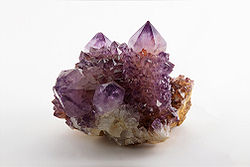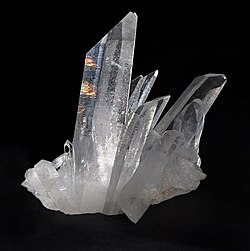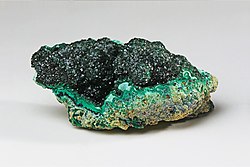Difference between revisions of "DPL Example table output"
(Created page with "For demonstration we use the properties of some minerals described in the Template:Infobox mineral. ===== show infobox details from articles using "Template:Infobox miner...") |
|||
| Line 1: | Line 1: | ||
For demonstration we use the properties of some minerals described in the [[Template:Infobox mineral]]. | For demonstration we use the properties of some minerals described in the [[Template:Infobox mineral]]. | ||
| − | + | == show infobox details from articles using "Template:Infobox mineral" == | |
<dpl> | <dpl> | ||
uses = Template:Infobox mineral | uses = Template:Infobox mineral | ||
| Line 9: | Line 9: | ||
</dpl> | </dpl> | ||
| − | + | == the same, as a table == | |
<dpl> | <dpl> | ||
uses = Template:Infobox mineral | uses = Template:Infobox mineral | ||
| Line 17: | Line 17: | ||
</dpl> | </dpl> | ||
| − | + | == sortable table plus some column formatting == | |
<dpl> | <dpl> | ||
uses = Template:Infobox mineral | uses = Template:Infobox mineral | ||
| Line 26: | Line 26: | ||
</dpl> | </dpl> | ||
| − | + | == more attributes == | |
<dpl> | <dpl> | ||
uses = Template:Infobox mineral | uses = Template:Infobox mineral | ||
| Line 34: | Line 34: | ||
</dpl> | </dpl> | ||
| − | + | == conditional formatting ('microcrystalline' in '''bold''') == | |
<dpl> | <dpl> | ||
uses = Template:Infobox mineral | uses = Template:Infobox mineral | ||
| Line 43: | Line 43: | ||
</dpl> | </dpl> | ||
| − | + | == include images == | |
<dpl> | <dpl> | ||
uses = Template:Infobox mineral | uses = Template:Infobox mineral | ||
| Line 53: | Line 53: | ||
| − | + | == include images and text portions == | |
<dpl> | <dpl> | ||
uses = Template:Infobox mineral | uses = Template:Infobox mineral | ||
Revision as of 09:04, 20 August 2012
For demonstration we use the properties of some minerals described in the Template:Infobox mineral.
Contents
show infobox details from articles using "Template:Infobox mineral"
- Amethyst : Purple, violet
- Quartz : From colorless to black, through various colors
- Malachite : Bright green, dark green, blackish green, commonly banded in masses; green to yellowish green in transmitted light ,
the same, as a table
| Mineral | Color |
|---|---|
| Amethyst | Purple, violet |
| Quartz | From colorless to black, through various colors |
| Malachite | Bright green, dark green, blackish green, commonly banded in masses; green to yellowish green in transmitted light |
sortable table plus some column formatting
| Mineral | Color |
|---|---|
| Amethyst | Purple, violet |
| Quartz | From colorless to black, through various colors |
| Malachite | Bright green, dark green, blackish green, commonly banded in masses; green to yellowish green in transmitted light |
more attributes
| Mineral | Color | Habit | Formula |
|---|---|---|---|
| Amethyst | Purple, violet | 6-sided prism ending in 6-sided pyramid (typical) | Silica (silicon dioxide, SiO2) |
| Quartz | From colorless to black, through various colors | 6-sided prism ending in 6-sided pyramid (typical), drusy, fine-grained to microcrystalline, massive | Silica (silicon dioxide, SiO2) |
| Malachite | Bright green, dark green, blackish green, commonly banded in masses; green to yellowish green in transmitted light | Massive, botryoidal, stalactitic, crystals are acicular to tabular prismatic | Cu2CO3(OH)2 |
conditional formatting ('microcrystalline' in bold)
| Mineral | Color | Habit | Formula |
|---|---|---|---|
| Amethyst | Purple, violet | 6-sided prism ending in 6-sided pyramid (typical) | Silica (silicon dioxide, SiO2) |
| Quartz | From colorless to black, through various colors | 6-sided prism ending in 6-sided pyramid (typical), drusy, fine-grained to microcrystalline, massive | Silica (silicon dioxide, SiO2) |
| Malachite | Bright green, dark green, blackish green, commonly banded in masses; green to yellowish green in transmitted light | Massive, botryoidal, stalactitic, crystals are acicular to tabular prismatic | Cu2CO3(OH)2 |
include images
| Mineral | Image | Color | Habit | Formula |
|---|---|---|---|---|
| Amethyst | 
|
Purple, violet | 6-sided prism ending in 6-sided pyramid (typical) | Silica (silicon dioxide, SiO2) |
| Quartz | 
|
From colorless to black, through various colors | 6-sided prism ending in 6-sided pyramid (typical), drusy, fine-grained to microcrystalline, massive | Silica (silicon dioxide, SiO2) |
| Malachite | 
|
Bright green, dark green, blackish green, commonly banded in masses; green to yellowish green in transmitted light | Massive, botryoidal, stalactitic, crystals are acicular to tabular prismatic | Cu2CO3(OH)2 |
include images and text portions
| Mineral | Description | Image | Color | Habit | Formula |
|---|---|---|---|---|---|
| Amethyst |
Amethyst is a purple variety of quartz (SiO2) and owes its violet color to irradiation, iron impurities (in some cases in conjunction with transition element impurities), and the presence of trace elements, which result in complex crystal lattice substitutions.<ref>Greenwood, Norman N.; Earnshaw, Alan (1997). Chemistry of the Elements (2nd ed.). Butterworth–Heinemann. ISBN </ref></nowiki></nowiki> ..→ |

|
Purple, violet | 6-sided prism ending in 6-sided pyramid (typical) | Silica (silicon dioxide, SiO2) |
| Quartz |
Quartz belongs to the trigonal crystal system. The ideal crystal shape is a six-sided prism terminating with six-sided pyramids at each end. In nature quartz crystals are often twinned, distorted, or so intergrown with adjacent crystals of quartz or other minerals as to only show part of this shape, or to lack obvious crystal faces altogether and appear massive. Well-formed crystals typically form in a 'bed' that has unconstrained growth into a void, but because the crystals must be attached at the other end to a matrix, only one termination pyramid is present. There are exceptions as doubly terminated crystals do ..→ |

|
From colorless to black, through various colors | 6-sided prism ending in 6-sided pyramid (typical), drusy, fine-grained to microcrystalline, massive | Silica (silicon dioxide, SiO2) |
| Malachite |
The stone's name derives (via Latin: molochītis, Middle French: melochite, and Middle English melochites) from Greek Μολοχίτης λίθος molochitis lithos, "mallow-green stone", from μολόχη molōchē, variant of μαλάχη malāchē, "mallow".<ref>Malachite, Dictionary.com</ref> The mineral was given this name due to its resemblance to the leaves of the Mallow plant.<ref>Harper, Douglas. "malachite". Online Etymology Dictionary ..→ |

|
Bright green, dark green, blackish green, commonly banded in masses; green to yellowish green in transmitted light | Massive, botryoidal, stalactitic, crystals are acicular to tabular prismatic | Cu2CO3(OH)2 |